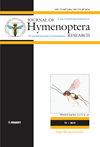Andrena Fabricius属,1775年在伊比利亚半岛(膜翅目,Andrenidae)
IF 1.4
3区 农林科学
Q2 ENTOMOLOGY
引用次数: 2
摘要
伊比利亚半岛是全球蜜蜂多样性的热点,因为它有大量不同的栖息地,特别是地中海灌木丛、山脉和冷热草原。根据其作为蜜蜂多样性热点的地位,该半岛拥有非常大的Andrena动物群,尽管近年来取得了进展,但对其的研究仍不完全,特别是在基因调查方面。在这里,对伊比利亚-安德列纳动物群进行了全面修订,共记录了228个物种。在对博物馆标本、模式材料和基因调查进行检查后,许多分类变化是必要的。描述了以下亚属:Prunosandrenasubgen。nov.,包含六个分类群,以前被置于Campylogaster Dours亚属,1873年和Blandarenasubgen。11月,Bryandenasubgen。11月,林安德列纳苏布根。nov.和Ovandenasubgen。nov.,包含一、一、一和四个分类群,以前被放在Poliandena Warncke亚属中,1968年。Andrena(Limandrena)toelgana Friese,1921年合成。nov.与A.(Limandrena)linbata Eversmann,1852年同义。A.(Micrandrena)obsoleta Pérez,1895年的当前选型被Warncke错误地指定;该分类单元与A.obsoleta senso-Warncke不同,属于A.mariana-Warncke,1968年复合体中的一个分类单元。为A.obsoletasp指定了一个新的选型。resur。来自阿尔及利亚的A.mariana solda Warncke,1974 syn。nov.与之同义;A.(Micrandrena)alma Warncke,1975年11月,A.(Micrandrena)mica Warnck,1974年11月和A.(Miclandrena)tenostra Warncke(1975年)被提升到物种地位。Andrena(Truncandrena)abunda Warncke,1974年11月,A。,A.(Prunosandrena)琥珀球菌,1872 sp.resurr。,和A.(Notandrena)varuga-Warncke,1975 stat.nov.也被恢复或提升为物种状态。为A.lavandulae Pérez(Euandrena)指定了一个选择型。其恢复到物种状态,和A.(Euandrena)impresa Warncke,1967 syn。nov.与之同义。Andrena(Truncandrena)nigropilosa Warncke,1967年统计。nov.被提升为物种地位。A。nov.与之同义为初级主观同义词。为A.(Melandrena)vachali Pérez指定了一个选模,1895年;A.(Melandrena)creberrima Pérez,1895年合成。nov.和A.(Melandrena)vachalisyn。nov.与A.(Melandrena)discors Erichson,1841和Andrena(Melandrina)hispania Warncke,1967 syn。nov.与A.(Melandrena)morio Brullé,1832年同义。安德列娜(普鲁诺安德列娜)马耶蒂·佩雷斯,1895年合成。nov.与A.(Prunosandena)caroli Pérez,1895年和A.(incertae sedis)setosa Pérez,1903年合成。nov.与A.(incertae sedis)ranunculum Morawitz,1877年新同义。Andrena(Simandrena)cilisaeformis Pérez,1895 sp.reserr。恢复到物种状态,是A.(Simandrena)breviscopa auctorum的正确名称。Andrena(incertae sedis)breviscopa Pérez,1895年与A.(incertae-sedis)numida Lepeletier,1841年重新成为同义词。11月与沼田A。安德列娜(Euandrena)孤立无援。nov.和A.(Micrandrena)ortizsp。nov.描述自内华达山脉(格拉纳达),A.(Truncadrena)ghisbainisp。nov.描述自马拉加省,和A.(Avandrena)juliaesp。nov.描述自加的斯省。描述了A.(Micrandrena)alma和A.(?Euandrena)ramosa Wood,2022的雄性。为A.(Plastandena)asperima Pérez,1895,A.(Plasandrena)atricapilla Pérez-1895,B.(Aenandrena)hystrix Schmiedeknecht,1883,A.(Prunosandena)lanuginosa Spinola,1843,A。新类型被指定为A.(Chlorandrena)boyerela Dours,1872,A.(Notandrena)griseobaltata Dours(1872),A.(Taeniandrena)poupillari Dours、A.(Prunosandena)琥珀豆豆豆豆,1872和A.(incertae sedis)numida Lepeletier,1841。每种情况下都会提供类型照片和诊断特征,以及研究不足物种的新饮食信息。最后,提出了一个识别密钥,以促进未来在其全球多样性热点之一对该超多样性属的研究,并讨论了伊比利亚-安德列纳目前和未来的研究前景。本文章由计算机程序翻译,如有差异,请以英文原文为准。
The genus Andrena Fabricius, 1775 in the Iberian Peninsula (Hymenoptera, Andrenidae)
The Iberian Peninsula is a global hotspot for bee diversity due to its large number of different habitats, particularly Mediterranean scrubland, mountains, and hot and cold steppe. In line with its status as a hotspot of bee diversity, the peninsula hosts a very large Andrena fauna, which despite progress in recent years remains incompletely studied, particularly with reference to genetic investigation. Here the Iberian Andrena fauna is comprehensively revised, resulting in a total of 228 recorded species. Numerous taxonomic changes are necessary following inspection of museum specimens, type material, and genetic investigation. The following subgenera are described: Pruinosandrenasubgen. nov., containing six taxa previously placed in the subgenus Campylogaster Dours, 1873, and Blandandrenasubgen. nov., Bryandrenasubgen. nov., Limbandrenasubgen. nov., and Ovandrenasubgen. nov., containing one, one, one, and four taxa previously placed in the subgenus Poliandrena Warncke, 1968. Andrena (Limbandrena) toelgiana Friese, 1921 syn. nov. is synonymised with A. (Limbandrena) limbata Eversmann, 1852. The current lectotype of A. (Micrandrena) obsoleta Pérez, 1895 was incorrectly designated by Warncke; the taxon differs from A. obsoleta sensu Warncke, belonging instead to a taxon within the A. mariana Warncke, 1968 complex. A new lectotype is designated for A. obsoletasp. resurr. from Algeria, and A. mariana solda Warncke, 1974 syn. nov. is synonymised with it; A. (Micrandrena) alma Warncke, 1975 stat. nov., A. (Micrandrena) mica Warncke, 1974 stat. nov., and A. (Micrandrena) tenostra Warncke, 1975 stat. nov. are raised to species status. Andrena (Truncandrena) abunda Warncke, 1974 stat. nov., A. (Micrandrena) lecana Warncke, 1975 stat. nov., A. (Pruinosandrena) parata Warncke, 1967 stat. nov., A. (Micrandrena) pauxilla Stöckhert, 1935 sp. resurr., A. (Pruinosandrena) succinea Dours, 1872 sp. resurr., and A. (Notandrena) varuga Warncke, 1975 stat. nov. are also returned or elevated to species status. A lectotype is designated for A. (Euandrena) lavandulae Pérez, 1902 sp. resurr. which is returned to species status, and A. (Euandrena) impressa Warncke, 1967 syn. nov. is synonymised with it. Andrena (Truncandrena) nigropilosa Warncke, 1967 stat. nov. is elevated to species status, and A. (Truncandrena) truncatilabris espanola Warncke, 1967 syn. nov. is synonymised with it as a junior subjective synonym. A lectotype is designated for A. (Melandrena) vachali Pérez, 1895; A. (Melandrena) creberrima Pérez, 1895 syn. nov. and A. (Melandrena) vachalisyn. nov. are synonymised with A. (Melandrena) discors Erichson, 1841, and Andrena (Melandrena) hispania Warncke, 1967 syn. nov. is synonymised with A. (Melandrena) morio Brullé, 1832. Andrena (Pruinosandrena) mayeti Pérez, 1895 syn. nov. is newly synonymised with A. (Pruinosandrena) caroli Pérez, 1895 and A. (incertae sedis) setosa Pérez, 1903 syn. nov. is newly synonymised with A. (incertae sedis) ranunculorum Morawitz, 1877. Andrena (Simandrena) cilissaeformis Pérez, 1895 sp. resurr. is returned to species status, and is the correct name for A. (Simandrena) breviscopa auctorum. Andrena (incertae sedis) breviscopa Pérez, 1895 is returned to synonymy with A. (incertae sedis) numida Lepeletier, 1841, and A. (incertae sedis) inconspicua Morawitz, 1871 is newly synonymised syn. nov. with A. numida. Andrena (Euandrena) isolatasp. nov. and A. (Micrandrena) ortizisp. nov. are described from the Sierra Nevada (Granada), A. (Truncandrena) ghisbainisp. nov. is described from Málaga province, and A. (Avandrena) juliaesp. nov. is described from Cádiz province. The males of A. (Micrandrena) alma and A. (?Euandrena) ramosa Wood, 2022 are described. Additional lectotypes are designated for A. (Plastandrena) asperrima Pérez, 1895, A. (Plastandrena) atricapilla Pérez, 1895, A. (Aenandrena) hystrix Schmiedeknecht, 1883, A. (Pruinosandrena) lanuginosa Spinola, 1843, A. (Notandrena) ranunculi Schmiedeknecht, 1883, and A. (Euandrena) symphyti Schmiedeknecht, 1883. Neotypes are designated for A. (Chlorandrena) boyerella Dours, 1872, A. (Notandrena) griseobalteata Dours, 1872, A. (Taeniandrena) poupillieri Dours, 1872, A. (Pruinosandrena) succinea Dours, 1872, and A. (incertae sedis) numida Lepeletier, 1841. Type photographs and diagnostic characters are presented in each case, as well as new dietary information for understudied species. Finally, an identification key is presented in order to facilitate future research on this hyper-diverse genus in one of their global diversity hotspots, and current and future research perspectives for Iberian Andrena are discussed.
求助全文
通过发布文献求助,成功后即可免费获取论文全文。
去求助
来源期刊
CiteScore
2.60
自引率
15.40%
发文量
68
审稿时长
>12 weeks
期刊介绍:
The Journal of Hymenoptera Research is a peer-reviewed, open-access, rapid online journal launched to accelerate research on all aspects of Hymenoptera, including biology, behavior, ecology, systematics, taxonomy, genetics, and morphology.
All published papers can be freely copied, downloaded, printed and distributed at no charge for the reader. Authors are thus encouraged to post the pdf files of published papers on their homepages or elsewhere to expedite distribution. There is no charge for color.

 求助内容:
求助内容: 应助结果提醒方式:
应助结果提醒方式:


